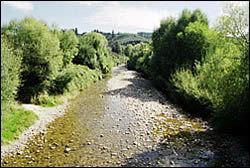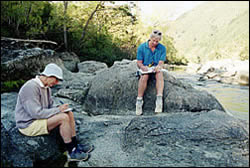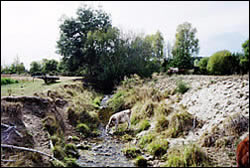Riparian classification
Research Status: Past |
Tadmor River showing exotic riparian vegetation |
Introduction
Riparian zones can perform a variety of functions that can be managed to protect the water quality of streams and rivers and to protect habitat for aquatic and terrestrial fauna. These zones are often needed to buffer the effects of land use on streams. However, their biophysical roles and human uses vary both with the type of landform and the position within the catchment.
In many situations there is a need to conduct some riparian restoration in order to restore health to streams. However, in places where the problems may be large and widespread, or where resources are limited, there is no easy way to prioritise what and where things should be done first. A riparian zone classification within a management framework enables improved understanding of the potential and limitations of riparian zone management as a catchment or watershed management tool.
Research Approach
A pilot classification system developed by John Quinn from NIWA for the Waikato and Canterbury regions of New Zealand has been used to type the riparian zones of the whole Moteuka catchment. This is a field-based assessment using a range of visual assessment criteria.
Research Results
As at end of April 2001, 156 stream sections were typed. These sections represent most of the easily accessible streams and rivers throughout the catchment. This data was combined with a number of spatial database attributes using discriminant analysis to derive current, potential and knowledge-based maps for reaches within the Motueka catchment.
Progress - June 2003
Final report completed - includes 3 Appendices. This is an unpublished report. Please cite the reference and the url.
 |
 |
Michael Marden and Lisa Langer carrying out riparian survey work |
Poor riparian habitat |
Recent Publications
BMPs, BEPs and Guidelines
| Title | Description |
| Lowland Plains and Drains | A companion guide to "Managing waterways on Canterbury farms". Part of Clean Streams. From...More » |
| Riparian Zone Management Guidelines |
From document: This Guideline is a practical manual for use by landowners, developers, organis...More » |
| Riparian Zone Management Planting Guide | Companion Guide to "Riparian Zone Management Guidelines"...More » |
| Waitakere District Plan Guidelines – Natural Areas | Riparian margins...More » |
| Native Plants for Streamsides in Wellington Conservancy |
Guideline helps reduce further loss of indigenous biodiversity by indicating the native plants ...More » |
| Streamside Planting Guide |
From website: The streamside planting guide will help you know what to plant where, and how to...More » |
Primary Contacts:

|
Michael Marden
Email Phone: 06 8631345 Fax: 06 8631346 More details» |
Institute Landcare Research |
Expertise Geology/Earth Sciences/Geomorphology/Erosion processes |

|
Chris Phillips
Email Phone: +64 3 321 9775 More details» |
Institute Landcare Research |
Expertise Erosion processes, slope stability, effects of forestry, catchment management, knowledge management |